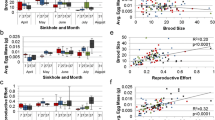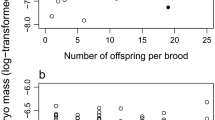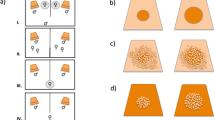Synopsis
The pike killifish, Belonesox belizanus, is native to Mexico and Central America and was introduced into Dade County, Florida in 1957. This study reports on the structure and reproduction of the Florida population and compares the species with other members of the family Poeciliidae. The mean standard length (SL) of mature females was about 103 mm. Most females larger than 75 mm SL contained yolked ova, fertilized eggs, or embryos. Mature males averaged about 72 mm SL, and most males larger than 55 mm SL were mature. The sex ratio was significantly skewed in favor of females among adults, but it did not differ significantly from 1:1 among immature fish. Average brood size was about 99, and there was a significant positive correlation of brood size with size of the parent female. There was no evidence of superfetation. Sizes and weights of embryos and neonates were the largest reported for the family. There was a significant decrease in mean embryo weight as development proceeded, indicating that developing embryos received little or no nutrient input from the maternal system after fertilization. The average interbrood interval of aquarium-held females was 42 days, and females stored viable sperm at least 47 days. Reproduction continued year round in the field. Laboratory-born neonates were immediately piscivorous and exhibited distinctive behavior associated with filling the swimbladder and with avoiding detection by predators.
Similar content being viewed by others
References cited
Barbour, T. & L.J. Cole. 1906. Reptilia, Amphibia, and Pisces. In: Vertebrata from Yucatan. Bull. Mus. Comp. Zool. 50: 155–159.
Barney, R.L. & B.J. Anson. 1921. The seasonal abundance of the mosquito-destroying topminnow, Gambusia affinis, especially in relation to fecundity. Anat. Rec. 22: 317–330.
Belshe, J.F. 1961. Observations of an introduced tropical fish (Belonesox belizanus) in Southern Florida. M.S. Thesis, University of Miami, Coral Gables. 71 pp.
Bonham, K. 1946. Management of a small farm pond in Texas. J. Wildlife Mgt. 10: 1–4.
Breder, C.M. & D.E. Rosen. 1966. Modes of reproduction in fishes. Natural History Press, Garden City. 941 pp.
Colson, C.M. 1969. Effects of day length and temperature on the reproduction of Heterandria formosa. Ph.D. Dissertation, University of Florida, Gainesville. 93 pp.
Connaly, H. 1968. The pike livebearer. Aquarium 2: 45–50.
Constantz, G.D. 1974. Reproductive effort in Poeciliopsis occidentalis. Southwest. Nat. 19: 47–52.
Günther, A.C.L.G. 1866. An account of the fishes of the states of Central America based on collections made by Capt. J.N. Dow, F. Godman, Esq., and O. Salvin, Esq. Trans. Zool. Soc. London 6: 377–495.
Hubbs, C.L. 1924. Studies of the fishes of the order Cyprinodontes. II. An analysis of the genera of the Poeciliidae. Misc. Publ. Univ. Mich. Mus. Zool. 13: 5–11.
Hubbs, C.L. 1926. Studies of the fishes of the order Cyprinodontes. IV. Material for a revision of the American genera and species. Misc. Publ. Univ. Mich. Mus. Zool. 16: 1–86.
Hubbs. C.L. 1936. Fishes of Yucatan Peninsula. pp. 157–287. In: A.S. Pearse, E.P. Creaser & F.G. Halls (ed.) The Cenotes of Yucatan, a Zoological and Hydrographic Survey, Carnegie Inst. Wash., Publ. 457.
Hubbs, Clark. 1964. Interactions between a bisexual fish species and its gynogenetic sexual parasite. Bull. Tex. Mem. Mus. 8: 1–72.
Hubbs, Clark. 1971. Competition and isolating mechanisms in the Gambusia affinis x G. heterochir hybrid swarm. Bull. Tex. Mem. Mus. 19: 1–47.
Jordan, D.S. & B.W. Everman. 1896. The fishes of North and Middle America. Part 1. U.S. Nat. Mus. Bull. 47: 1–1240.
Krumholz, L.A. 1948. Reproduction in the western mosquitofish, Gambusia a. affinis, and its use in mosquito control. Ecol. Monogr. 18: 1–43.
Krumholz, L.A. 1963. Relation between fertility, sex ratio, and exposure to predation in populations of the mosquitofish Gambusia manni Hubbs at Bimini, Bahamas. Int. Revue ges. Hydrobiol. 48: 201–256.
Liley, N.R. 1966. Ethological isolating mechanisms in four sympatric species of poeciliid fishes. Behavior (Supplement) 13: 1–197.
Medlin, A.B. 1951. Preliminary observations on the effects of temperature and light upon reproduction in Gambusia affinis. Copeia 1951: 148–152.
Meek, S.E. 1904. The freshwater fishes of Mexico north of the Isthmus of Tehuantepec. Publ. Field Columbian Mus., Zoological Ser. 5: 1–252.
Miley, W.W. 1978. Ecological impact of the pike killifish, Belonesox belizanus Kner (Poecihidae), in southern Florida. M.S. Thesis, Florida Atlantic University, Boca Raton. 55 pp.
Regan, C.T. 1913. A revision of the cyprinodont fishes of the sub-family Poeciliinae. Proc. Zool. Soc. London. 2: 177–1018.
Rosen, D.C. & R.M. Bailey. 1963. The poeciliid fishes (Cyprinodontiformes), their structure, zoogeography, and systematics. Bull. Amer. Mus. Nat. Hist. 126: 1–176.
Rosenthal, H.L. 1952. Observations on reproduction of the poeciliid Lebistes reticulatus (Peters). Biol. Bull. 102: 30–38.
Scrimshaw, N.S. 1944. Superfetation in poeciliid fishes. Copeia 1944: 180–183.
Scrimshaw, N.S. 1945. Embryonic development in poeciliid fishes. Biol. Bull. 88: 233–246.
Scrimshaw, N.S. 1946. Egg size in poeciliid fishes. Copeia 1946: 20–23.
Schultz, R.J. 1961. Reproductive mechanism of unisexual and bisexual strains of the viviparous fish Poeciliopsis. Evolution 15: 302–325.
Self, J.T. 1940. Notes on the sex cycle of Gambusia a. affinis and on its habitats and relation to mosquito control Amer. Midl. Nat. 23: 393–398.
Shafland, P.L. & J.M. Pestrak. 1982. Lower lethal temperatures for fourteen non-native fishes in Florida. Env. Biol. Fish. 7: 149–156.
Sciliano, M.J. 1972. Evidence for a spontaneous ovarian cycle in fish of the genus Xiphophorus. Biol. Bull. 142: 480–488.
Snelson, F.F., Jr. & J.D. Wetherington. 1980. Sex ratio in the sailfin molly, Poecilia latipinna. Evolution 34: 308–319.
Stearns, S.C. & R.D. Sage. 1980. Maladaptation in a marginal population of the mosquitofish, Gambusia affinis. Evolution 34: 65–75.
Tavolga, W.N. 1949. Embryonic development of the platyfish (Platypoecilus), the swordtail (Xiphophorus), and their hybrids. Bull. Amer. Mus. Nat. Hist. 94: 161–230.
Thibault, R.E. & R.J. Schultz. 1978. Reproductive adaptations among viviparous fishes (Cyprinodontiformes: Poeciliidae). Evolution 32: 320–333.
Turner, C.L. 1937. Reproductive cycles and superfetation in poeciliid fishes. Biol. Bull. 72: 145–164.
Turner, C.L. 1938. The reproductive cycle of Brachyraphis episcopi, an ovoviviparous poeciliid fish in the natural tropical habitat. Biol. Bull. 75: 56–65.
Turner, C.L. 1940a. Pseudoamnion, pseudochorion, and follicular pseudoplacenta in poeciliid fishes. J. Morph. 67: 59–89.
Turner, C.L. 1940b. Superfetation in viviparous cyprinodontid fishes. Copeia 1940: 88–91.
Turner, C.L. 1942. Diversity of endocrine function in the reproduction of viviparous fishes. Amer. Nat. 76: 179–190.
Turner, C.L. 1947. Viviparity in teleost fishes. Sci. Month. 65: 508–518.
Turner, J.S. 1981. Population structure and reproduction in the introduced Florida population of the pike killifish, Belonesox belizanus (Pisces: Poeciliidae). M.S. Thesis, University of Central Florida, Orlando. 56 pp.
Van Oordt, G.J. 1928. The duration of life of the spermatozoa in the fertilized female of Xiphophorus helleri Regan. Verveniging (J. Zool. Soc. Netherlands) Ser. 3, 1–2: 77–80.
Wourms, J.P. 1981. Viviparity: the maternal-fetal relationship in fishes. Amer. Zool. 21: 473–515.
Author information
Authors and Affiliations
Rights and permissions
About this article
Cite this article
Turner, J.S., Snelson, F.F. Population structure, reproduction and laboratory behavior of the introduced Belonesox belizanus (Poeciliidae) in Florida. Environ Biol Fish 10, 89–100 (1984). https://doi.org/10.1007/BF00001665
Received:
Accepted:
Issue Date:
DOI: https://doi.org/10.1007/BF00001665




